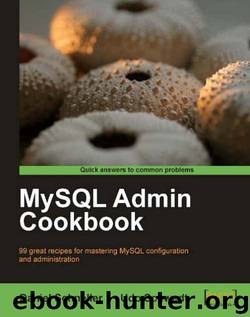MySQL Admin Cookbook by Daniel Schneller & Udo Schwedt

Author:Daniel Schneller & Udo Schwedt [Daniel Schneller]
Language: eng
Format: epub, mobi
Publisher: Packt Publishing
There's more...
While the previous SELECT … INTO OUTFILE statement will work well in most cases, there are some circumstances in which you still might encounter problems. The following topics will show you how to handle some of those.
Handling errors if the target file already exists
If you try to execute the SELECT … INTO OUTFILE statement twice, an error File 'C:/target.csv' already exists occurs. This is due to a security feature in MySQL that makes sure that you cannot overwrite existing files using the SELECT … INTO OUTFILE statement. This makes perfect sense if you think about the consequences. If this were not the case, you could overwrite the MySQL data files using a simple SELECT because MySQL server needs write access to its data directories. As a result, you have to choose different target files for each export (or remove old files in advance).
Unfortunately, it is not possible to use a non-constant file name (like a variable) in the SELECT … INTO OUTFILE export statement. If you wish to use different file names, for example, with a time stamp as part of the file name, you have to construct the statement inside a variable value before executing it:
mysql> SET @selInOutfileCmd := concat("SELECT * FROM sample.table1 INTO OUTFILE 'C:/target-", DATE_FORMAT(now(),'%Y-%m-%d_%H%i%s'), ".csv' FIELDS ENCLOSED BY '\"' TERMINATED BY ';' ESCAPED BY '\"' LINES TERMINATED BY '\r\n';");mysql> PREPARE statement FROM @selInOutfileCmd;mysql> EXECUTE statement;
Download
MySQL Admin Cookbook by Daniel Schneller & Udo Schwedt.mobi
This site does not store any files on its server. We only index and link to content provided by other sites. Please contact the content providers to delete copyright contents if any and email us, we'll remove relevant links or contents immediately.
Algorithms of the Intelligent Web by Haralambos Marmanis;Dmitry Babenko(8586)
Building Statistical Models in Python by Huy Hoang Nguyen & Paul N Adams & Stuart J Miller(7498)
Azure Data and AI Architect Handbook by Olivier Mertens & Breght Van Baelen(7495)
Serverless Machine Learning with Amazon Redshift ML by Debu Panda & Phil Bates & Bhanu Pittampally & Sumeet Joshi(7373)
Driving Data Quality with Data Contracts by Andrew Jones(7130)
Data Wrangling on AWS by Navnit Shukla | Sankar M | Sam Palani(7127)
Machine Learning Model Serving Patterns and Best Practices by Md Johirul Islam(6857)
Learning SQL by Alan Beaulieu(6192)
Weapons of Math Destruction by Cathy O'Neil(6116)
Big Data Analysis with Python by Ivan Marin(5830)
Data Engineering with dbt by Roberto Zagni(4837)
Solidity Programming Essentials by Ritesh Modi(4464)
Time Series Analysis with Python Cookbook by Tarek A. Atwan(4299)
Pandas Cookbook by Theodore Petrou(4000)
Blockchain Basics by Daniel Drescher(3474)
Natural Language Processing with Java Cookbook by Richard M. Reese(3046)
Hands-On Machine Learning for Algorithmic Trading by Stefan Jansen(3010)
Feature Store for Machine Learning by Jayanth Kumar M J(2898)
Learn T-SQL Querying by Pam Lahoud & Pedro Lopes(2865)
